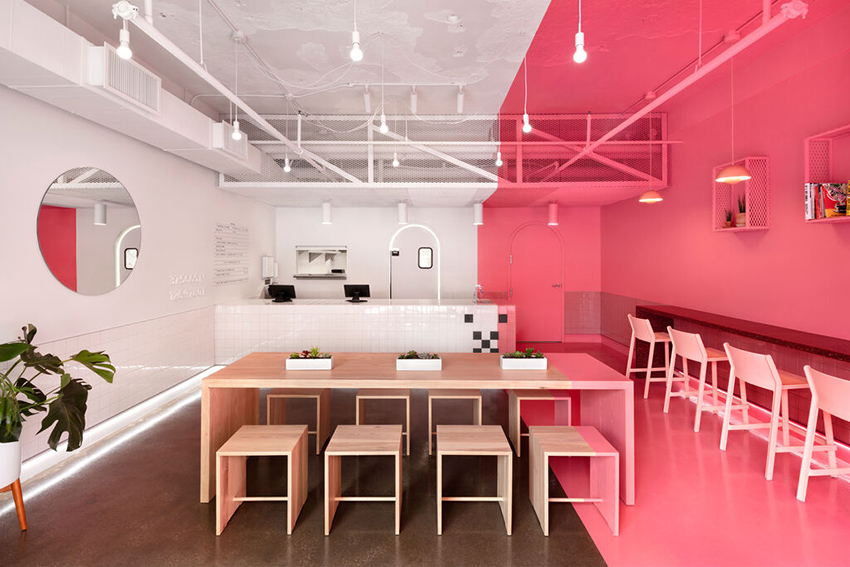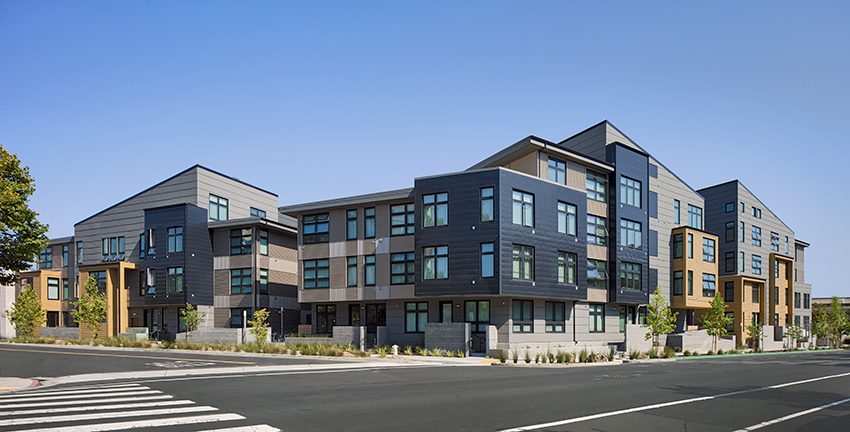This course is part of the Multifamily Housing Academy
It’s no secret that extruded aluminum is a force of versatility in the built environment. Its range of exterior and interior applications, as well as an ability to blend with other materials or bend to a multitude of shapes without sacrificing strength and durability, are key to its popularity. Recently, extruded aluminum has evolved to become even more customized for multifamily and commercial projects to support the health, safety, and well-being of building occupants. One interesting aspect of these innovations is the expanding ability of vendors to do in-house collaborations with architects and specifiers. This new partnership promises more possibilities for the architectural world, where the synthesis of ideas is as strong as the material it works to develop.
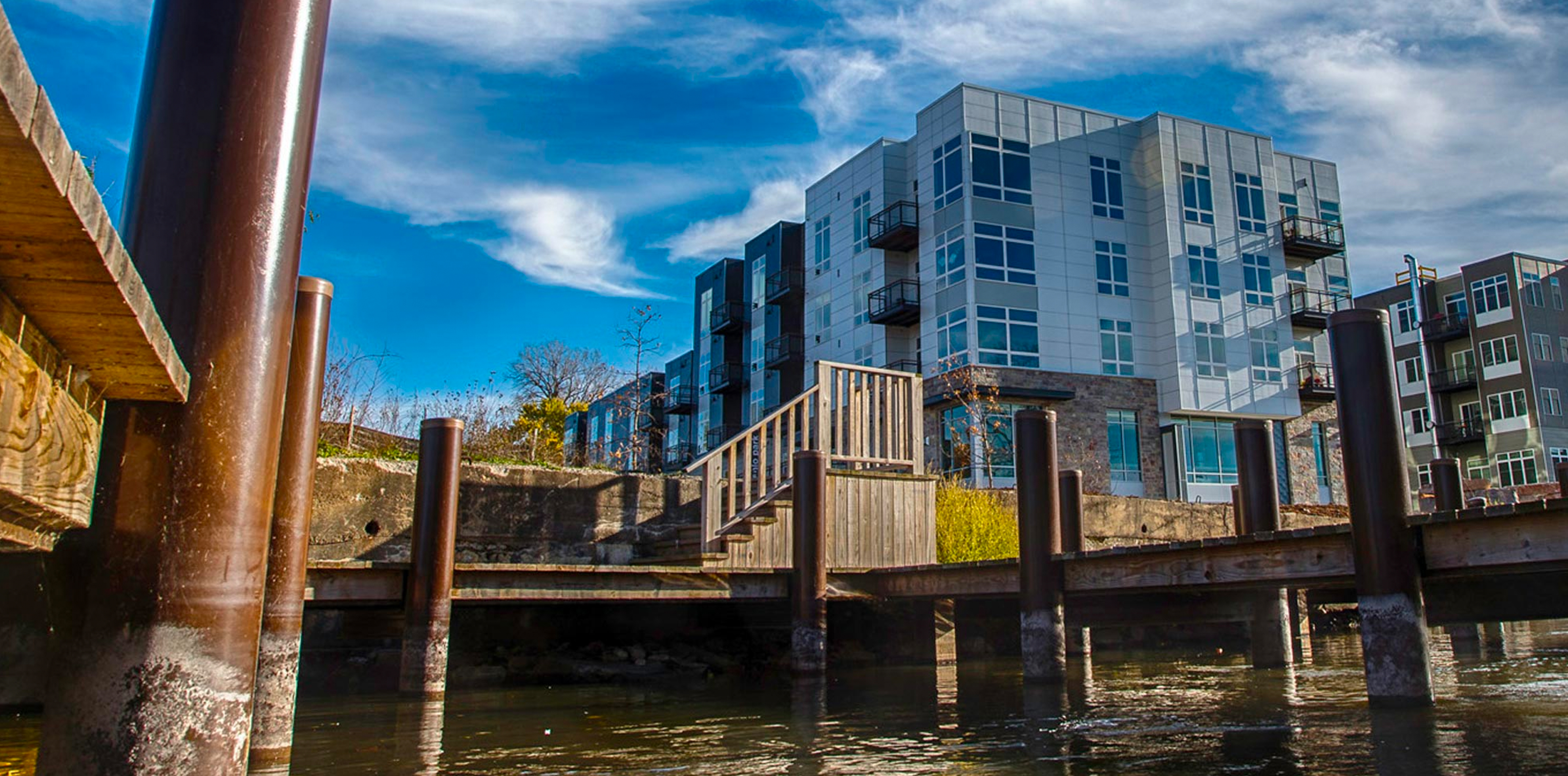
Courtesy of Engberg Anderson Architects
Prairie Riverheath Way, a multifamily project located on the Fox River in Appleton, Wis., was designed with extruded aluminum trim for a modern look that reflects the town’s natural and urban aesthetics.
The Versatility Of Extruded Aluminum
This section will provide a brief overview of extruded aluminum, discussing its versatility in terms of exterior and interior applications for multifamily and commercial use. It will list the reasons aluminum is such a popular material and provide an overview of its performance characteristics and finishes. It also will discuss important health and safety elements that extruded aluminum provide for building occupants. Finally, this section will bolster the concept that extruded aluminum has continued to expand its value with new parts and fabrications, and that as vendors and architects work together, these exciting developments can continue to evolve.
Why Extruded Aluminum?
Extruded aluminum is unlike many other building materials because it does not need to fit standard profiles. It can be shaped to fit the design and structural needs of a given project, and that flexibility is beneficial for multifamily and commercial properties. The popular material provides high-quality practical shapes, forms, and profiles that have the appearance of fine metal craft and can be integrated easily into other surfaces for significantly less cost than custom metal work. Overall, its clean appearance works well with modern designs.
Aluminum is the most abundant metal in the earth’s crust. It is always found as a compound and often with bauxite ore, which contains around 30–60% aluminum oxide (known as alumina). Aluminum can be extracted from the bauxite and then smelted to form the aluminum metal that most people know. Because it is lightweight and durable, works in alloys, and is readily available through new extractions and recycled materials, aluminum is widely used in the transportation, packaging, and construction industries. It resists corrosion and is tolerant of high temperatures, making it ideal for commercial aircraft. It also is nontoxic and has low reactivity to light, water, and oxygen, which is ideal for food packaging as well as construction purposes – from windows and roofing to structural frames, gutters, and external and interior trim.
To get these versatile products, alumina first must undergo smelting and alloying. During this process, solid billets of cast metal are created, and these are later extruded through specialized forms to create the finished product. Following the extrusion process, the material is finished with anodizing or painting. The finishing process provides a range of colors, textures, and brightness to the aluminum.
Most extruded shapes used for architectural purposes are made from Type 6063–T5 aluminum. This aluminum alloy made with magnesium and silicon is commonly referred to as the “architectural alloy.” It has a very smooth surface that is well suited for anodizing applications. The T5 designation indicates that it has been artificially aged and moderately heat-treated for strength.
Characteristics of Extruded Aluminum
Extruded aluminum is frequently referred to as the “miracle metal” because it has such an extensive list of favorable properties. These properties make it ideal not just for transportation uses such as commercial aircraft and trucking, or for food packaging, but also for many different applications in the building industry.
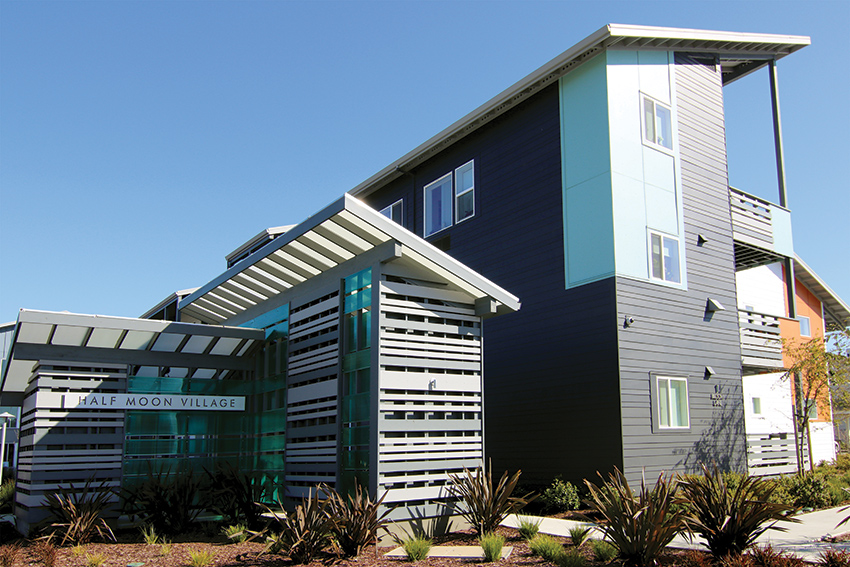
Photo Courtesy of Herman Coliver Locus Architecture
Half Moon Village in Half Moon Bay, Calif., was designed with extruded aluminum to provide a modern, sleek look that affordable housing for seniors has not always had in the past.
Durability
Aluminum’s physical properties and characteristics are at the core of its versatility. As a material, it is strong, durable, and resilient – all while being lightweight. While some materials are damaged on impact, aluminum can spring back (or be pushed back) to its original form. And unlike other metals, it doesn’t rust, thanks to its own naturally occurring oxide film. When used for interior architectural purposes, aluminum trim can withstand daily use and long-term wear and tear better than most other materials, and that makes it a great option for multifamily residential projects. For example, it’s tough enough to protect corners and bases, but unlike trim made from either PVC or wood, it won’t deteriorate or warp, and it isn’t prone to insect damage. Extruded aluminum trim is also lightweight and very easy to install; these features alone can be a great time and money saver during construction.
Health and Safety Benefits
Aluminum ranks high in health and safety benefits. The pandemic has led to wider discussion in the fields of architecture and building design about how pathogens and people intersect in the built environment. That conversation has led to exciting ideas in current R&D that focus on the ways materials and construction can produce healthier spaces both now and in the future.
For that reason, specifiers must carefully consider how material choices might impact the spread of viruses, bacteria, and infectious diseases in all kinds of spaces. Research has demonstrated a significant difference in the longevity of viruses on a variety of surfaces, and a variety of treatments appear to further reduce the growth and survival of viruses and bacteria, enhancing the ability of a surface to destroy pathogens.
One major study in the Journal of Hospital Infection tested human coronavirus strains for longevity on material surfaces. The study found that the virus only lasted two to eight hours on aluminum, while lasting days on other surfaces such as steel and plastics.
Finishing technologies also proved to be beneficial toward reducing longevity of viruses and bacteria. Anodizing, etching, sealing, painting, and coating technologies can add antimicrobial properties to the aluminum surfaces, making them inhospitable to bacteria and viruses.
In addition, aluminum products – given their thermal conductivity, high corrosion resistance, and durable finish properties – withstand aggressive cleaning and disinfection techniques and facilitate effective sanitation.
Aluminum extrusions are also naturally free of Volatile Organic Compounds (VOCs), whether in mill finish, anodized, or painted. Liquid paint coatings that are subject to low VOC restrictions and standards and managed during application in the manufacturing facility and are not associated with off-gassing once they are cured.
Chemicals and compounds considered to be worst-in-class materials in terms of toxicity or health impacts when used in products for the building industry are known as Red List materials. Many chemicals on this list bio-accumulate up the food chain and reach toxic, more concentrated levels in humans. Avoiding Red List products is intended to ensure that building occupant health is protected. Extruded aluminum building products – and their constituent elements – do not appear on the Red List.
The Red List of chemicals and substances harmful to humans is compiled by the International Living Future Institute (ILFI) as part of its Living Building Challenge (LBC). The materials section of the LBC aims to remove the worst known offending materials and practices, and to shine light on the need for transparent and transformative industrial practices. Products that contain Red List substances must not be used if a building is to achieve Living Building status. There is a “small component” clause in the Red List that allows trace amounts of Red List chemicals to be present, but builders must first look for alternatives and substitutes that do not contain Red List items. Short and medium chain chlorinated paraffins (SCCPs and MCCPS) used as lubricants and coolants are highly toxic. Toxic heavy metals such as arsenic, cadmium, lead, chromium VI, and mercury all cause threats to human health, and are not added to aluminum alloys for any known application.
It’s no secret that extruded aluminum is a force of versatility in the built environment. Its range of exterior and interior applications, as well as an ability to blend with other materials or bend to a multitude of shapes without sacrificing strength and durability, are key to its popularity. Recently, extruded aluminum has evolved to become even more customized for multifamily and commercial projects to support the health, safety, and well-being of building occupants. One interesting aspect of these innovations is the expanding ability of vendors to do in-house collaborations with architects and specifiers. This new partnership promises more possibilities for the architectural world, where the synthesis of ideas is as strong as the material it works to develop.

Courtesy of Engberg Anderson Architects
Prairie Riverheath Way, a multifamily project located on the Fox River in Appleton, Wis., was designed with extruded aluminum trim for a modern look that reflects the town’s natural and urban aesthetics.
The Versatility Of Extruded Aluminum
This section will provide a brief overview of extruded aluminum, discussing its versatility in terms of exterior and interior applications for multifamily and commercial use. It will list the reasons aluminum is such a popular material and provide an overview of its performance characteristics and finishes. It also will discuss important health and safety elements that extruded aluminum provide for building occupants. Finally, this section will bolster the concept that extruded aluminum has continued to expand its value with new parts and fabrications, and that as vendors and architects work together, these exciting developments can continue to evolve.
Why Extruded Aluminum?
Extruded aluminum is unlike many other building materials because it does not need to fit standard profiles. It can be shaped to fit the design and structural needs of a given project, and that flexibility is beneficial for multifamily and commercial properties. The popular material provides high-quality practical shapes, forms, and profiles that have the appearance of fine metal craft and can be integrated easily into other surfaces for significantly less cost than custom metal work. Overall, its clean appearance works well with modern designs.
Aluminum is the most abundant metal in the earth’s crust. It is always found as a compound and often with bauxite ore, which contains around 30–60% aluminum oxide (known as alumina). Aluminum can be extracted from the bauxite and then smelted to form the aluminum metal that most people know. Because it is lightweight and durable, works in alloys, and is readily available through new extractions and recycled materials, aluminum is widely used in the transportation, packaging, and construction industries. It resists corrosion and is tolerant of high temperatures, making it ideal for commercial aircraft. It also is nontoxic and has low reactivity to light, water, and oxygen, which is ideal for food packaging as well as construction purposes – from windows and roofing to structural frames, gutters, and external and interior trim.
To get these versatile products, alumina first must undergo smelting and alloying. During this process, solid billets of cast metal are created, and these are later extruded through specialized forms to create the finished product. Following the extrusion process, the material is finished with anodizing or painting. The finishing process provides a range of colors, textures, and brightness to the aluminum.
Most extruded shapes used for architectural purposes are made from Type 6063–T5 aluminum. This aluminum alloy made with magnesium and silicon is commonly referred to as the “architectural alloy.” It has a very smooth surface that is well suited for anodizing applications. The T5 designation indicates that it has been artificially aged and moderately heat-treated for strength.
Characteristics of Extruded Aluminum
Extruded aluminum is frequently referred to as the “miracle metal” because it has such an extensive list of favorable properties. These properties make it ideal not just for transportation uses such as commercial aircraft and trucking, or for food packaging, but also for many different applications in the building industry.

Photo Courtesy of Herman Coliver Locus Architecture
Half Moon Village in Half Moon Bay, Calif., was designed with extruded aluminum to provide a modern, sleek look that affordable housing for seniors has not always had in the past.
Durability
Aluminum’s physical properties and characteristics are at the core of its versatility. As a material, it is strong, durable, and resilient – all while being lightweight. While some materials are damaged on impact, aluminum can spring back (or be pushed back) to its original form. And unlike other metals, it doesn’t rust, thanks to its own naturally occurring oxide film. When used for interior architectural purposes, aluminum trim can withstand daily use and long-term wear and tear better than most other materials, and that makes it a great option for multifamily residential projects. For example, it’s tough enough to protect corners and bases, but unlike trim made from either PVC or wood, it won’t deteriorate or warp, and it isn’t prone to insect damage. Extruded aluminum trim is also lightweight and very easy to install; these features alone can be a great time and money saver during construction.
Health and Safety Benefits
Aluminum ranks high in health and safety benefits. The pandemic has led to wider discussion in the fields of architecture and building design about how pathogens and people intersect in the built environment. That conversation has led to exciting ideas in current R&D that focus on the ways materials and construction can produce healthier spaces both now and in the future.
For that reason, specifiers must carefully consider how material choices might impact the spread of viruses, bacteria, and infectious diseases in all kinds of spaces. Research has demonstrated a significant difference in the longevity of viruses on a variety of surfaces, and a variety of treatments appear to further reduce the growth and survival of viruses and bacteria, enhancing the ability of a surface to destroy pathogens.
One major study in the Journal of Hospital Infection tested human coronavirus strains for longevity on material surfaces. The study found that the virus only lasted two to eight hours on aluminum, while lasting days on other surfaces such as steel and plastics.
Finishing technologies also proved to be beneficial toward reducing longevity of viruses and bacteria. Anodizing, etching, sealing, painting, and coating technologies can add antimicrobial properties to the aluminum surfaces, making them inhospitable to bacteria and viruses.
In addition, aluminum products – given their thermal conductivity, high corrosion resistance, and durable finish properties – withstand aggressive cleaning and disinfection techniques and facilitate effective sanitation.
Aluminum extrusions are also naturally free of Volatile Organic Compounds (VOCs), whether in mill finish, anodized, or painted. Liquid paint coatings that are subject to low VOC restrictions and standards and managed during application in the manufacturing facility and are not associated with off-gassing once they are cured.
Chemicals and compounds considered to be worst-in-class materials in terms of toxicity or health impacts when used in products for the building industry are known as Red List materials. Many chemicals on this list bio-accumulate up the food chain and reach toxic, more concentrated levels in humans. Avoiding Red List products is intended to ensure that building occupant health is protected. Extruded aluminum building products – and their constituent elements – do not appear on the Red List.
The Red List of chemicals and substances harmful to humans is compiled by the International Living Future Institute (ILFI) as part of its Living Building Challenge (LBC). The materials section of the LBC aims to remove the worst known offending materials and practices, and to shine light on the need for transparent and transformative industrial practices. Products that contain Red List substances must not be used if a building is to achieve Living Building status. There is a “small component” clause in the Red List that allows trace amounts of Red List chemicals to be present, but builders must first look for alternatives and substitutes that do not contain Red List items. Short and medium chain chlorinated paraffins (SCCPs and MCCPS) used as lubricants and coolants are highly toxic. Toxic heavy metals such as arsenic, cadmium, lead, chromium VI, and mercury all cause threats to human health, and are not added to aluminum alloys for any known application.
Thermal Comfort
Aluminum extrusions have high thermal conductivity and typically require thermal insulation barriers within the aluminum frame to prevent heat loss (or gain) and to prevent condensation on the inside surfaces of window frames. Thermal barriers use polyamide strips or “poured and debridged” polyurethane to achieve optimal insulation properties – 500 to 1,300 times lower than the aluminum itself – within the extruded aluminum framing. These resin barriers are designed to maintain their hardened, solid state contained within the aluminum frame and not degrade, leach, or off-gas into the environment, and so they are considered nontoxic to building occupants.
Sustainability
Aluminum extrusions offer engineers, architects, and product designers a unique combination of attributes that can lead to outstanding product solutions. Strong, lightweight, corrosion-resistant, capable of complex shapes with tight tolerances, engineered performance, and infinitely recyclable, extrusions are ideally suited to today’s world where climate change continues to be a worsening issue.
Aluminum is the only material that will pay for itself over its lifespan thanks to recyclability. During extrusion manufacturing, most processed and new scrap is fed back into the billet production process. At the end of life, aluminum scrap is collected and sold—via a well-established infrastructure—to secondary smelting operations for billet production. Numerous extruders operate their own secondary smelting facilities in addition to purchasing billet from independent secondary smelters.
The recycling rate for aluminum products has proven to be quite high. According to a recent environmental product declaration (EPD) based on the life cycle analysis of extruded aluminum, it is estimated that 100 percent of aluminum extrusions are recycled at the end of life. However, at this point, 95 percent represents a defensible recycling rate for aluminum extrusion products in the building and transportation sectors, so if this rate is used, it is assumed that the remaining 5 percent goes to landfill. No co-products are generated from the production process.
Extruded Aluminum on the Cutting-Edge
This section will discuss the ways in which extruded aluminum has recently expanded. It will look at new developments in finishes and profiles, as well as the integration of additional technology. It will then discuss the ways in which extruded aluminum has evolved in terms of performance and safety, including fire resistance as well as the codes and standards that go along with these new developments.
Batten: Aesthetics and Well-Being
Batten or Board and Batten originated as a form of house siding, providing an exterior texture as a common style for arts-and-crafts architecture. Its popularity has reemerged over the past decade, and it has expanded to multifamily and commercial designs. Its unique aesthetic manages to evoke a rustic chic and handmade quality that is also wholly contemporary. In the past, battens were often made of wood that would rot or crack or otherwise need maintenance. That issue led to a shift away from board and batten toward other siding materials—vinyl, stone, and stucco, for instance.
But the emergence of extruded aluminum as a detail element, which can emulate the look of wood without the heavy maintenance, has led architects and building owners back to specifying for batten as an element of design. While their increased access to extruded aluminum manufacturers has allowed them to modernize the batten.
Batten plays with shadow and light, giving a building a dynamic interplay with the sun throughout the day. It can evoke a comfort quality—a nostalgic sense of harkening back to simple times, like the feeling of a farmhouse. It also can provide an urban chic quality for commercial buildings looking to evoke an atmosphere of dynamic innovation. What architects began to ask was can we have the batten be a lower profile off the board, which wouldn’t be possible with wood or other materials, but can be done with an extrusion. The result is a modern batten that only projects off the wall an 1/8 inch or ¼ inch, still giving the light interplay while blending greater in the facade. The versatility of extruded aluminum for finishes and colors shift the mood and style across a broad spectrum. The feelings that batten can evoke support the idea that good quality aesthetic design produces positive emotional experiences for the occupant and enhances happiness and well-being.
Some of the latest technologies in extruded aluminum batten emulate and shift the look of wood batten without the high maintenance and also serve as rustproof flashing between vertical siding. The aluminum alloy and coating of the batten protect against harsh weather and allow for paint adhesion and other finishes. The profiles are primarily placed vertically and can be finished with a variety of modern colors or finished in a weathering steel for a rustic look.

Graphic courtesy of TAMLYN
The projected batten-style vertical provides a subtle aesthetic design that blends into the facade while still providin
dynamic light interplay.
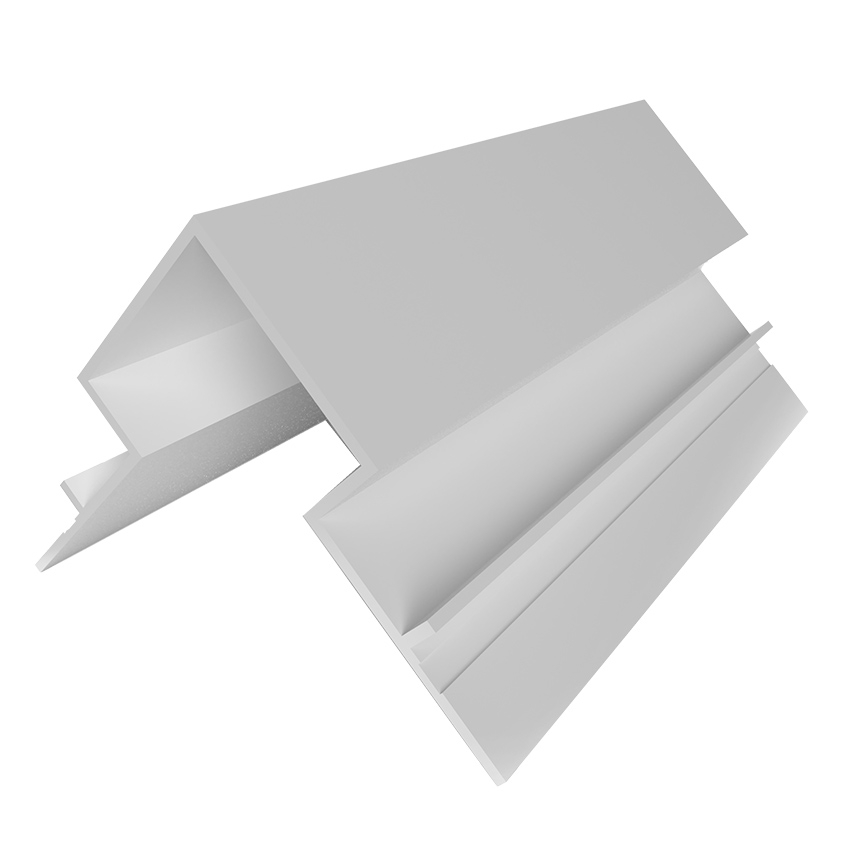
Graphic courtesy of TAMLYN
Batten corners have a bold, unique corner look that pairs well with vertical bead reveal.
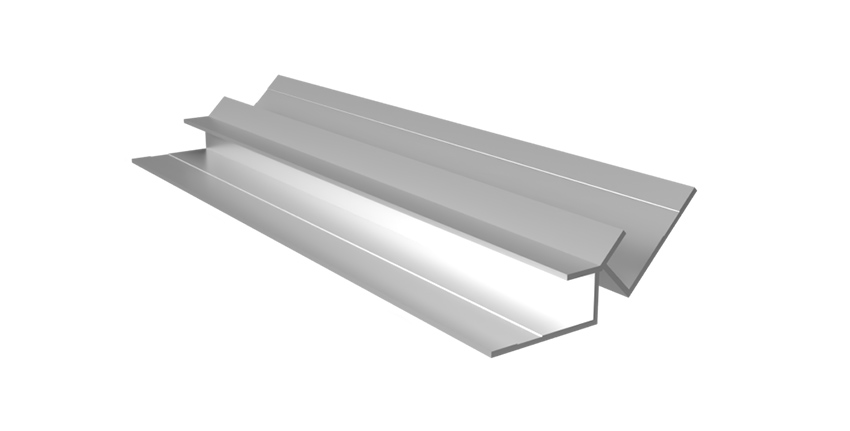
Graphic courtesy of TAMLYN
This is the 135-degree inside corner, which will work well with multiple profiles and corresponds to 90-degree standard
profiles in face sides.
Outside and Inside Corners
To compliment the modern batten profiles are corners made of extruded aluminum that are an important innovation as they provide bold corner designs with low maintenance. The bold corners include stops that create attractive reveal shadow lines at the corner. A similar design is also available with faces that cover the edge of the panel providing a buffer for error in installation, which adds to the easy appeal of using the extruded aluminum batten corners without concern for a reinstall, which would cost money and time.
Other outside corner technology includes 135-degree low profiles and 135-degree reveal open outside corners, both of which work well with vertical options and correspond in face sizes to 90-degree standard corners.
Another innovation that allows for even more flexibility on angled corners are “multi-angle profiles,” that are two-part systems that provide a 20-90 degree range.
Yet another design that brings a modern twist to traditional panels are blunt panel outside corners, which give a chamfered corner aesthetic, but also provide durability for vertical siding panels. Based on designer feedback there is another version of this with a reveal which gives a setback chamfer corner look. Led again by the architectural community and the sharing of ideas, there are new unique asymmetrical corners with a 1:3 exposure, which are great for buildings with longer facades as a result of site conditions.
Inside corners also come in a variety of shapes. A bullnose corner—which can give a soft adobe shape—works well for vertical siding panels. Another design emulates the look of a wood corner piece, without the issues of maintaining the integrity of a wood that can split and rot over time.
These varieties of inside and outside corner shapes and the ability to color match multiple siding systems allow architects and owners to dramatically improve their building aesthetics and create modern architectural lines with easy installation.
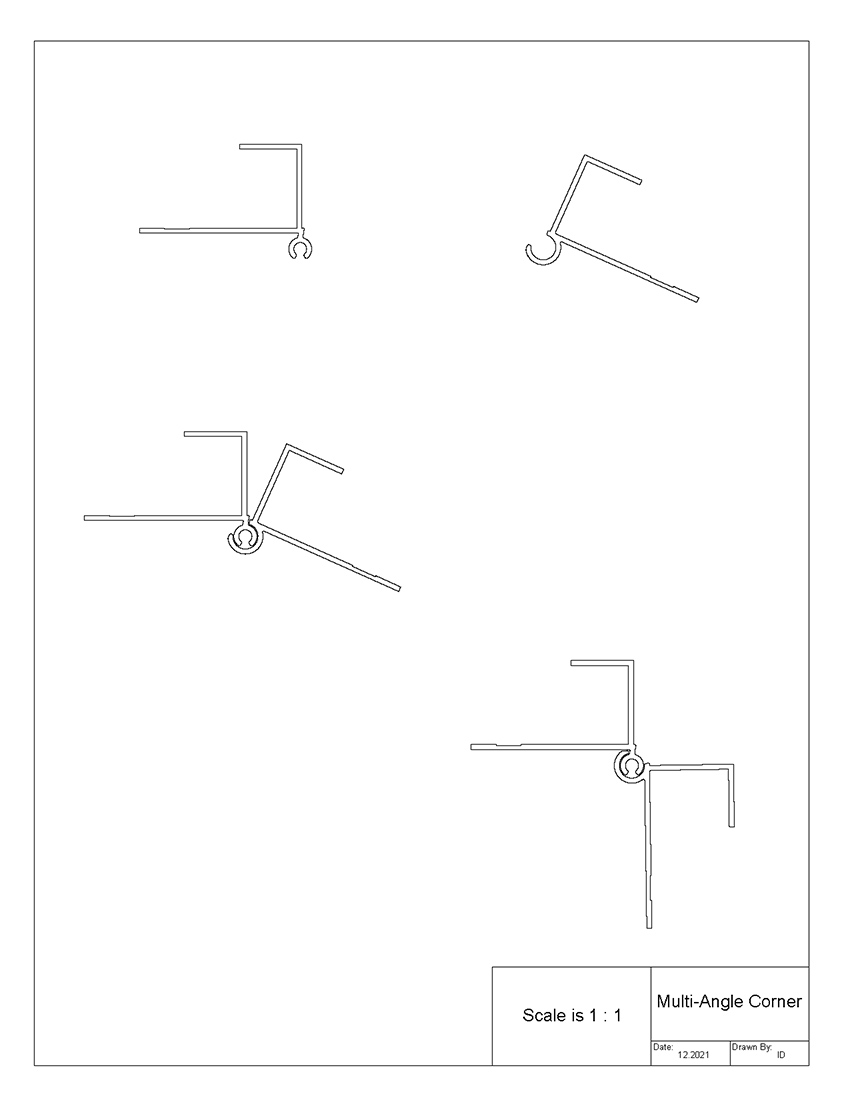
Drawing courtesy of TAMLYN
Some corners work for multi-angle profiles that are two-part systems ranging from 20-90 degrees.
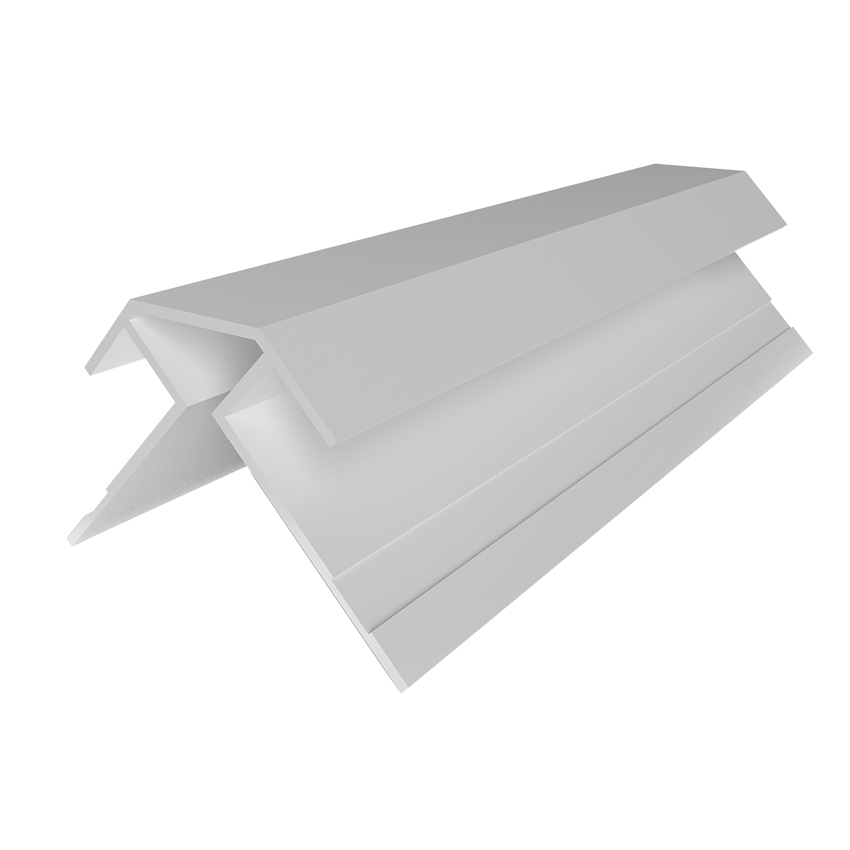
Graphic courtesy of TAMLYN
A blunt corner look has an attractive modern look while still maintaining strength for vertical siding panels.
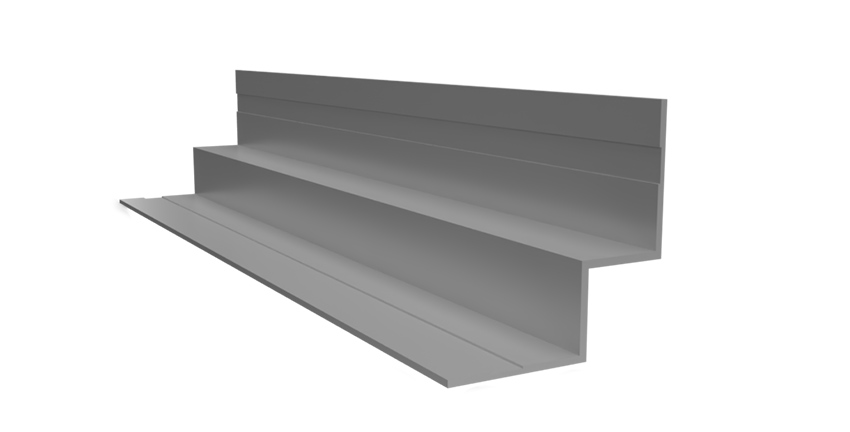
Graphic courtesy of TAMLYN
This is a W inside corner which can be used to replace wood corner pieces.
LED Strips
The use of light-emitting diodes (LEDs) has grown rapidly because of the energy use and maintenance costs. The U.S. Department of Energy (DOE) estimated that nearly 50 million LEDs have been installed in applications ranging from indoors to streetlights to parking garages. However, the rise in use of LEDs has created new challenges for lighting fixture manufacturers. LEDs require little maintenance and can be installed in all kinds of dynamic environments, so the fixtures also must be easy to maintain and durable.
Aluminum extrusion fixtures have become a solid solution to the challenge. LEDs are cool to the touch within the devices themselves, but they still emit unwanted heat due to inefficient semiconductors that generate the light. Aluminum extrusion fixtures serve as excellent heat sinks while also reflecting more light. In more unpredictable environments, such as outdoor settings where they are not sheltered from weather, aluminum fixtures provide a corrosion-resistant alternative to other more costly fixtures.
Design-wise, the flexibility of aluminum fixtures brings more possibilities. The material can incorporate effects such as lenses, circuit boards, and end-caps but also lets designers create fixtures in any shape they desire with almost any artistic style imaginable. The low-maintenance, high-style quality allows more flexibility both in function and aesthetics. Rather than just being a necessary response to the LED phenomenon, extruded aluminum can be seen as a desirable material for product designers.
One of the latest LED technologies is LED strips that can be housed in aluminum extrusions. This kind of LED lighting tends to look more finished than unhoused strips and therefore more aesthetically pleasing. The profile prevents damage to the LED lighting and is especially useful in areas where the lighting might come into contact with people or moisture. Aluminum extrusions help enhance the appearance of the LED strip lighting. They are often placed around a ceiling or behind televisions, in bathrooms around a sink, above a dresser or any other furniture or interior element that might benefit from illumination.
LED strip technology has bright capabilities and can be specified according to lumens per foot for a variety of applications. The strip lights also come in an array of colors and color combinations that can be integrated into the profiles.
With LED strip technology, aesthetic and thermal benefits apply. The thermal benefits of combining LED strips with aluminum profiles have a major impact on occupant comfort. Extruded aluminum’s ability to work as a heat sink and provide better light reflection both contribute to the positive indoor environmental quality (IEQ) of a space, directly elevating the comfort, well-being, and overall happiness of the occupant.
Fire Rating
Another new technology for extruded aluminum is the emergence of fire-rated profiles. These profiles use a factory-applied intumescent strip along the back wall of the profile. The strip allows drywall designs to achieve 1- and 2-hour fire ratings without requiring an extra layer of drywall. It swells when heated, protecting the profile underneath, and completely sealing the gap in the drywall in the event of a fire, preventing it from passing through.
The fire-rated profiles have a clean finish design with reveal detail for drywall terminations at ceilings, windows, doors, and other material transitions. They can be installed vertically or horizontally and transition between drywall and other materials and drywall and floors.
Fire-rated profiles are third-party fire tested per ASTM E119, and Standard Test Methods for Fire Test of Building Construction and Materials are listed under WFCi Report #20091.
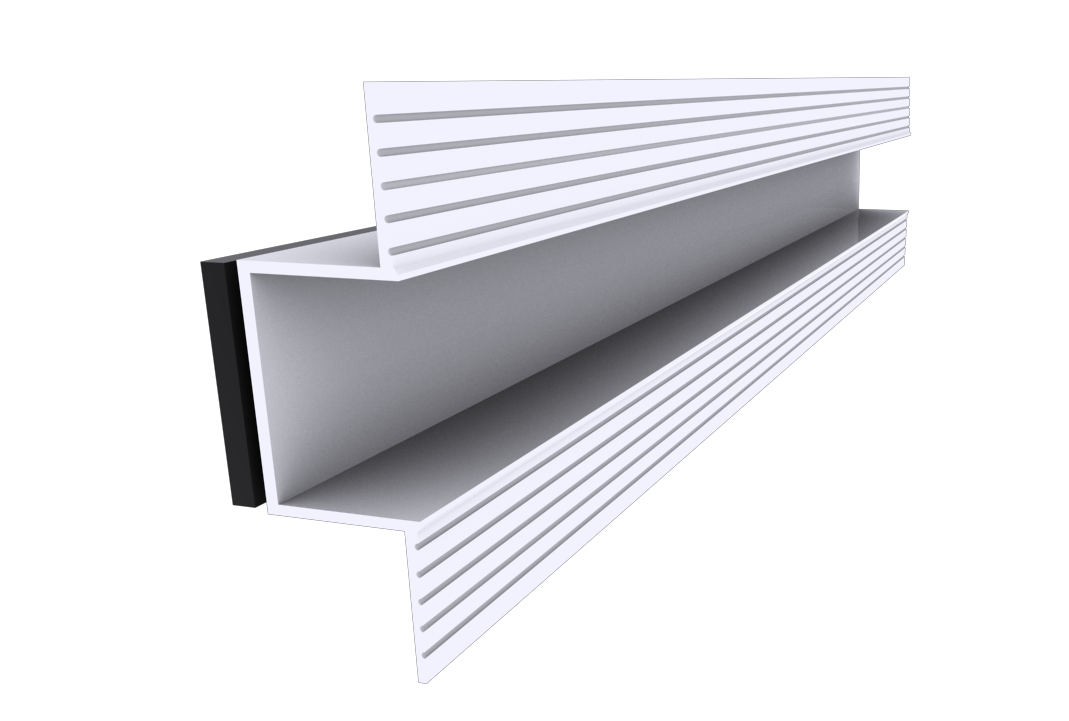
Graphic courtesy of TAMLYN
Fire-rated extruded aluminum profiles allow drywall designs to achieve 1- and 2-hour fire ratings without requiring another
layer of drywall.
Intersections
Welding for extruded aluminum intersections has come a long way. These days, there are several options for creating clean intersecting lines. The trim can be miter cut and welded on the nailing flanges, the flanges can be notched on the receiving trim, or if several intersecting lines come together in close proximity, a one-piece grid can be fabricated. Mitered 3-way and 4-way configurations as well as inside and outside corners for both interior and exterior products can be created. The standard size is 6" x 6" but some manufacturing partners will custom fabricate jobs for easy installation.
When Vendors and Architects Collaborate
When vendors are involved in the design process, they can help bring to fruition the architectural vision of any project. The potential for creative partnerships in the built environment is vast in terms of both multifamily and commercial buildings. It’s not just about meeting basic design needs; it comes down to innovative solutions that truly elevate a project and meet the health, safety, and wellness needs of building occupants.
It always helps a project when architects communicate well with manufacturers on components and design processes. But taking it a step further and collaborating on these projects can promote a seamlessness that is beneficial to everyone on so many levels. These are the kinds of projects that cultivate holistic, in-depth knowledge and synergy that can result in major successes and award-winning designs.
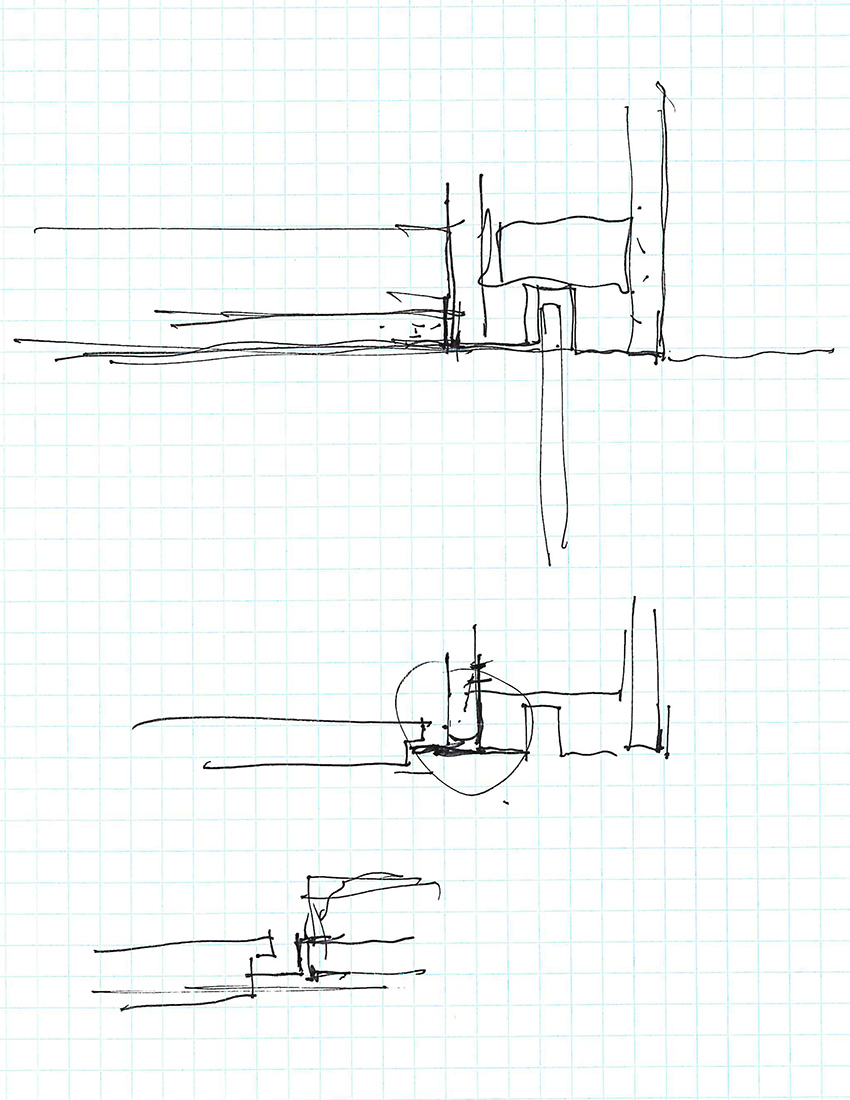
Drawing courtesy of TAMLYN and FLAD Architecture
Collaboration between manufacturer and designer starts with a first charette in which architects provide initial sketches of their wall assembly and details to the manufacturers.
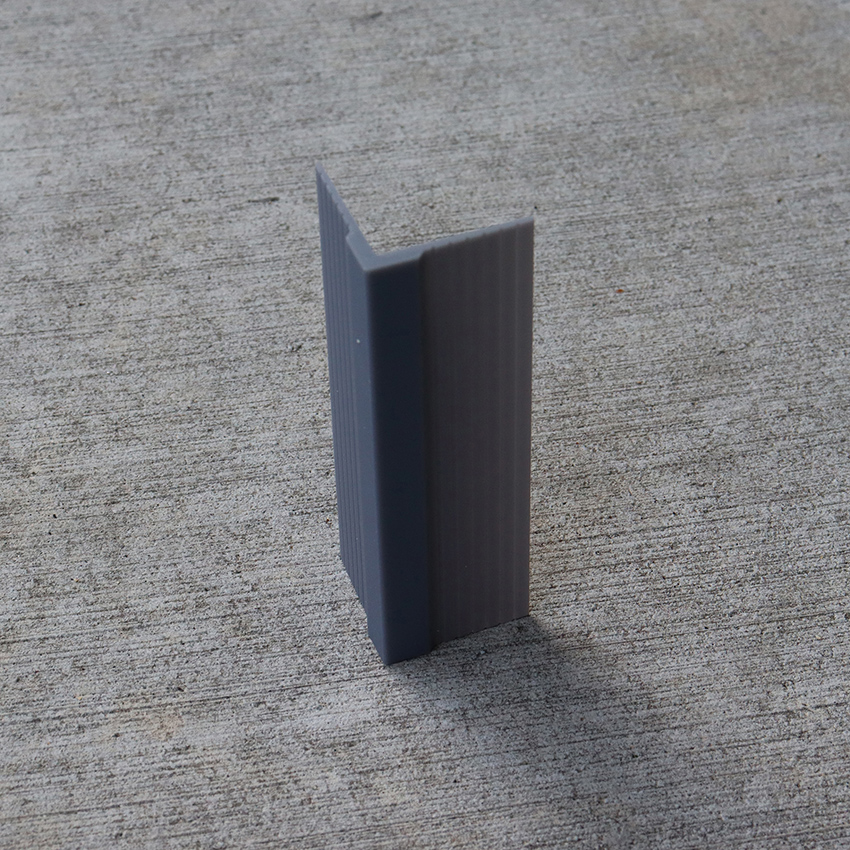
SLA is a cost-effective 3D-printing method that produces the high accuracy and smooth surface finishes like this extruded aluminum printed corner.
In the case of extruded aluminum, there are several ways designers and manufacturers might collaborate on the goal of a successful project. In the first charette, architects can provide an initial idea of their design vision and work with manufacturers to sketch out the detail conditions of the wall assembly. The manufacturer examines this vision and asks a series of questions focusing on dimension, environmental needs, and possible ideas for what the desired finish might look like. This initial conversation also focuses on a timeline for the project and quantity requirements for the materials needed. Once the manufacturer has gathered this information they will produce an initial CAD drawing of the profile to share with the Architect for their approval.
Once timeline, quantity, and general vision are pinned down, the 3D printing process can begin.
The 3D printer makes the design according to the original sketch created by architect and the CAD drawing created by the manufacturer. A common 3D technique is stereolithography (SLA), an additive manufacturing process that belongs to the photopolymerization family.
Also called resin 3D printing, polymerization uses visible light or ultraviolet to initiate and propagate a polymerization reaction to form a linear crosslinked polymer structure. SLA, in particular, uses UV lasers as a light source. The process allows for the creation of objects through the curation of polymer resin, in layers, using the UV laser beam. SLA uses photosensitive thermoset polymers that come in a liquid form.
SLA is cost-effective and produces high accuracy and smooth surface finishes, which is what the extruded aluminum requires. The SLA printing was first patented in 1986 and it continues to be one of the most cost-effective 3D technologies available when parts of very high accuracy or smooth surface finish are needed. When the designer takes advantage of the benefits and limitations of the manufacturing process, that’s when the best results are achieved.
Because of aluminum’s flexibility, there are nearly endless possibilities for these shapes and sizes, which is why the early collaboration is important. Architects might not know what is possible, while the manufacturer—without understanding the desired goals of the architect—might not have enough information to help the architect imagine something outside the box. The type of brainstorming that could happen in the initial charette has the capacity to produce innovative profiles that lead to big-picture innovations.
Timing for 3D printing is about two weeks and requires written approval from the architect and a code will be applied for specification and drawing purposes, which allows all stakeholders to solidify and sign off on the agreed-upon profiles. This stage at times will be repeated depending upon the feedback of the architect if there has been a change to project needs. Or it could be a step back to a new charrette.
Once the 3D print has been approved and the architect has signed off, the manufacturer will take over creating the needed die drawings for extrusion. Along the way, the collaboration includes die sample checks to keep the extruded parts aligned with the original 3D prints/die drawings. This process mostly falls upon the manufacturer, but it entails constant confirmation with the architect designs, maintaining that close working relationship.
Some architects may feel that collaboration with manufacturers somehow compromises their independence, but in fact, it is this kind of collaboration that leads to innovation, efficiency, and cost savings. One example of that is that insurance companies often support partnerships between architects and manufacturers, offering incentives like lower deductibles and reduced bonding costs, especially when joint reviews are done before any work on the project begins.
Starting collaboration from the beginning and keeping it dynamic throughout the project cycle provide more gains for the architect who might not only achieve their vision but surpass it beyond what they had originally imagined.
Case Studies
This section will look at two case studies that illustrate the latest technology integrations for extruded aluminum and showcases the way manufacturers worked with designers to execute the projects.
Conclusion
It’s no secret that extruded aluminum is a force of versatility in the built environment. Its range of exterior and interior applications as well as an ability to blend with other materials or bend to a multitude of shapes without sacrificing strength and durability are key to its popularity. Recently, extruded aluminum has evolved to become even more customized for multifamily and commercial projects to support the health, safety, and well-being of building occupants. One interesting aspect of these innovations is the expanding ability of vendors to do in-house collaborations with architects and specifiers. This new partnership promises more possibilities for the architectural world, where the synthesis of ideas is as strong as the material it works to develop.
Erika Fredrickson is an independent writer and editor focusing on technology, the environment, and history. She is a frequent contributor for continuing education courses and publications through Confluence Communications. http://www.confluencec.com












